The Gràcia Neighborhood & Giving Barcelona a Second Chance
I had a couple of bad first impressions of Barcelona that almost made me want to conclude the city was one big, loud, tourist theme park.
To kick off my flying-by-the-seat-of-my-pants trip around France in 2012, I took the trenhotel from southern Spain to Barcelona and spent a layover in the Catalan capital, intending to take a second night train to Paris that evening. I checked off all the main sights in the old town: the cathedral, the Boqueria market, Santa María del Mar, the historical museum, the Picasso museum, even a rediscovered synagogue. However, due to a combination of poorly-announced commuter train delays and poor planning on my part, I missed the night train to Paris by five minutes. Fortunately I was able to get a spot on the high-speed TGV leaving that morning and find a bed at a seven-euro hostel nearby…ah, the glory days.
I returned to Barcelona a couple months later to attend a concert by the Icelandic band Sigur Rós on the top of Montjuïc hill. This weekend trip was all about the arts: in addition to music, I appreciated art at the Museu Nacional d’Art de Catalunya and the Joan Miró museum, and I also checked off all seven of Antoni Gaudí’s scintillating buildings in Barcelona. But in between rushing from one museum to another Gaudí house, something felt…lacking.
That winter I was back in Barcelona for a layover, this time on my way to Italy. But I arrived in the evening and had to get up at 4am to catch the airport bus, so my only memories of this trip involve threading a path through the disorienting hellhole that is the Sants train station and wading through all the traffic and tourists in Plaça de Catalunya.
It wasn’t until June of 2015 that I realized Barcelona wasn’t so bad after all, but not for the reasons that most folks visit the city in droves. The neighborhood of Gràcia, far to the north of the touristy core, totally changed how I felt about Barcelona.
Over the years, this charming district slowly made its way onto my radar screen. Jessica of Barcelona Blonde first tipped me off to Gràcia after she moved into an apartment there; I was so amazed that such a cool place was hiding in plain sight in the middle of a world-class city! And then the folks at Devour Spain expanded their food tours in Madrid to Catalunya, inaugurating their Barcelona branch with a food tour of this neighborhood. It was clear I had to return to see what all the hype was about!
So when I did get back to Barcelona two summers ago, I decided to forgo a centrally-located hostel in the Barri Gòtic and instead go for one nestled up against the foothills of Park Güell. From my perch on the northern edge of Gràcia I hopped from one bustling plaza to another, grabbing snacks at locals-only vermouth bars along the way.
Now, what makes Gràcia, well, Gràcia?
I think the biggest thing that sets this neighborhood apart from the rest of the Big City is its small-town feel. Gràcia was actually once a separate village north of Barcelona’s historic center, but as the city sprawled around the turn of the century, the Vila de Gràcia was essentially absorbed into the city. Even today, the area still retains narrow, sometimes-wandering streets with small block sizes and apartment homes that rarely reach more than three stories tall. These cozy city streets are broken up by a handful of lively plazas where folks sip coffee or beer on sunny patios and kids kick soccer balls off of parish church walls.
Compared to the endless traffic of the Eixample district to the south, few cars clog up the roads here, making the neighborhood a quiet escape from the city whose only soundtrack is the conversations of locals who ran into each other on the street, garlic sizzling in frying pans through kitchen windows, and milk wailing as it steams in tiny coffee shops.
Of course, Gràcia can get pretty loud in its own right—especially in the summer during the weeklong Festa Major de Gràcia. As my friend Jessica recounts, the whole neighborhood gets festooned in whimsical decorations and denizens celebrate all night long, but having fireworks go off at ungodly hours can make sleep, uh, difficult. But hey, what’s a Spanish small town without its annual party?
In many ways Gràcia is also what much of Barcelona used to be like before the core was overwhelmed by tourists and cruise ship daytrippers. Here, there’s nary a Starbucks to be found; instead, closet-sized “supermarkets” offer the essential groceries for the day while family-owned coffee shops, bars, and restaurants are the norm, not the exception. In Gràcia’s major market, the Mercat de l’Abaceria Central, you’ll run into more two-wheeled shopping totes than camera-toting visitors. And you might feel like you’re intruding when you step in to a tavern with sun-bleached posters, dusty wine bottles in the rafters, and regulars who have been regulars for probably decades—but that’s the mark of an authentic spot, to be sure.
To top it all off, you’ll likely see no other fellow tourists in Gràcia, so you’ll feel like you have the whole neighborhood to yourself while you’re there.
There’s no finer pleasure in Gràcia than tasting everything the neighborhood has to offer, from the traditional Catalan apéritif of vermouth to Catalan staples like pa amb tomàquet, toast rubbed with tomatoes. Where to eat, then?
L’Anxoveta (C/ Sant Domènec, 16) is a great place to start; after all, its name is Catalan for “the anchovy”! I dipped in here on a sleepy Sunday but was quickly awoken after trying their signature bomba tapa—a hefty potato croquette paired with savory aioli and spicy tomato sauce meant to recall the bombs thrown by anarchists during the Spanish Civil War.
I had a quality breakfast at Can Tosca (C/Torrent de l’Olla, 77) during my brief stay in this neighborhood. Their café con leche was a little runny, but they made up for it with a sandwich of tender botifarra sausage placed between two toasted slices of thin, bubbly pa de vidre bread rubbed with juicy tomatoes.
Ca’l Pep (C/ Verdi, 141) was the most authentic place I visited in Barcelona. The average age here was around 60, leafed-through newspapers lay on every table, and large barrels of homemade vermouth sat out in the open—I even saw one guy come in with an empty jug and fill up his own stash to take home. If you get nothing else here, get their boquerones en vinagre; these cured anchovies are seriously the best I’ve ever tasted in Spain, super tender and not fishy at all.
I stumbled across Inch Bar (C/ Escorial, 117) on my daily hikes down and back up to the hostel. Although it looked barely an inch wide from the street, it opened up inside and served me a refreshing local Moritz beer and open-face sausage sandwich.
La Vermut (C/ Sant Domènec, 15), as the name would suggest, is a great place to try this typical Catalan apéritif. Decorated in a spare black, white, and red color scheme, it focuses your attention on the food and drinks. I recommend pairing a red vermouth with paper-thin slices of fuet sausage.
It was bars and restaurants like these that helped me finally gain a healthy appreciation for Barcelona—even if they made me want to never leave the neighborhood of Gràcia at all.
Have you ever spent time in Gràcia before? Would this neighborhood make you rethink your impressions of Barcelona? Share your thoughts below in the discussion thread!
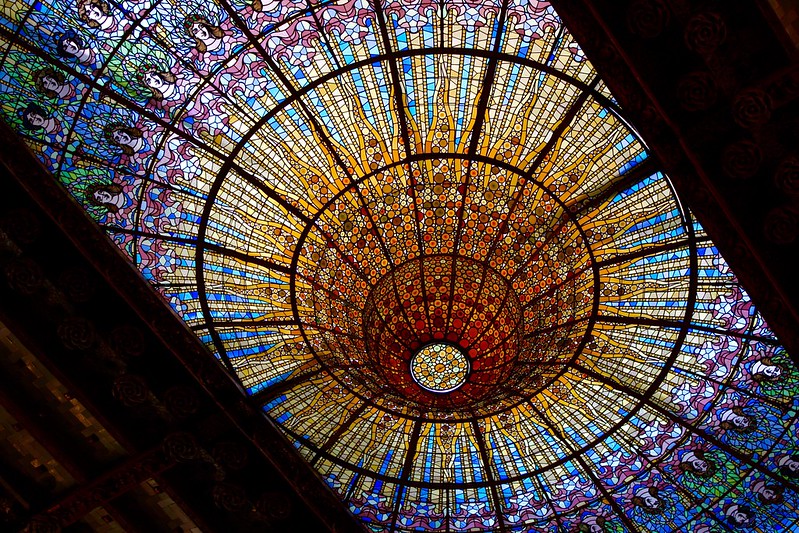
To kick off my flying-by-the-seat-of-my-pants trip around France in 2012, I took the trenhotel from southern Spain to Barcelona and spent a layover in the Catalan capital, intending to take a second night train to Paris that evening. I checked off all the main sights in the old town: the cathedral, the Boqueria market, Santa María del Mar, the historical museum, the Picasso museum, even a rediscovered synagogue. However, due to a combination of poorly-announced commuter train delays and poor planning on my part, I missed the night train to Paris by five minutes. Fortunately I was able to get a spot on the high-speed TGV leaving that morning and find a bed at a seven-euro hostel nearby…ah, the glory days.
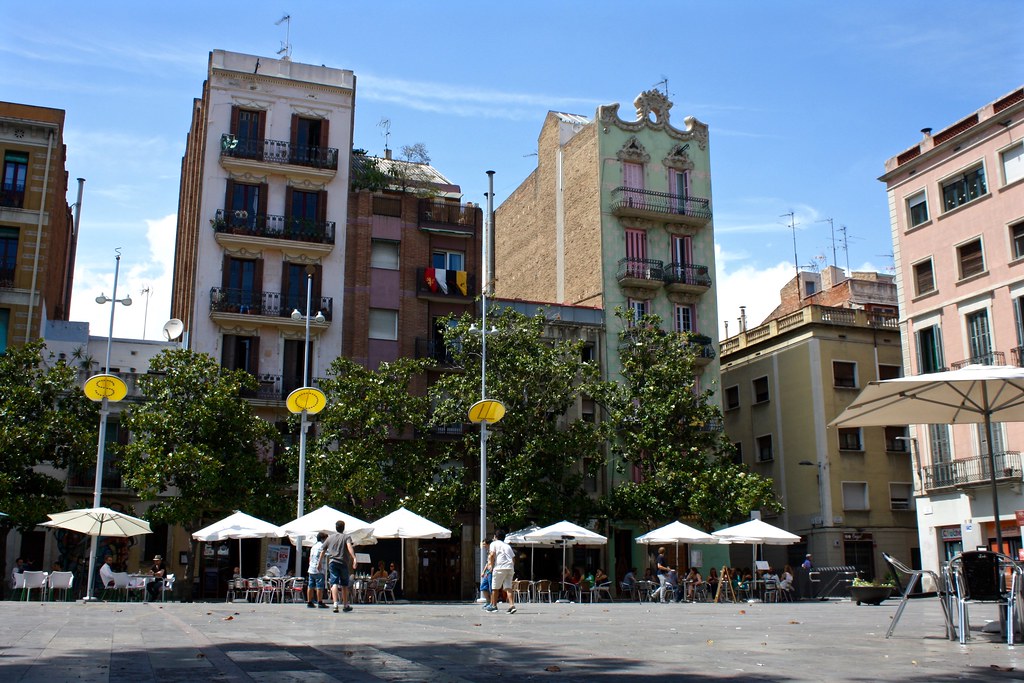 |
| Plaça del Sol, Gràcia |
I returned to Barcelona a couple months later to attend a concert by the Icelandic band Sigur Rós on the top of Montjuïc hill. This weekend trip was all about the arts: in addition to music, I appreciated art at the Museu Nacional d’Art de Catalunya and the Joan Miró museum, and I also checked off all seven of Antoni Gaudí’s scintillating buildings in Barcelona. But in between rushing from one museum to another Gaudí house, something felt…lacking.
That winter I was back in Barcelona for a layover, this time on my way to Italy. But I arrived in the evening and had to get up at 4am to catch the airport bus, so my only memories of this trip involve threading a path through the disorienting hellhole that is the Sants train station and wading through all the traffic and tourists in Plaça de Catalunya.
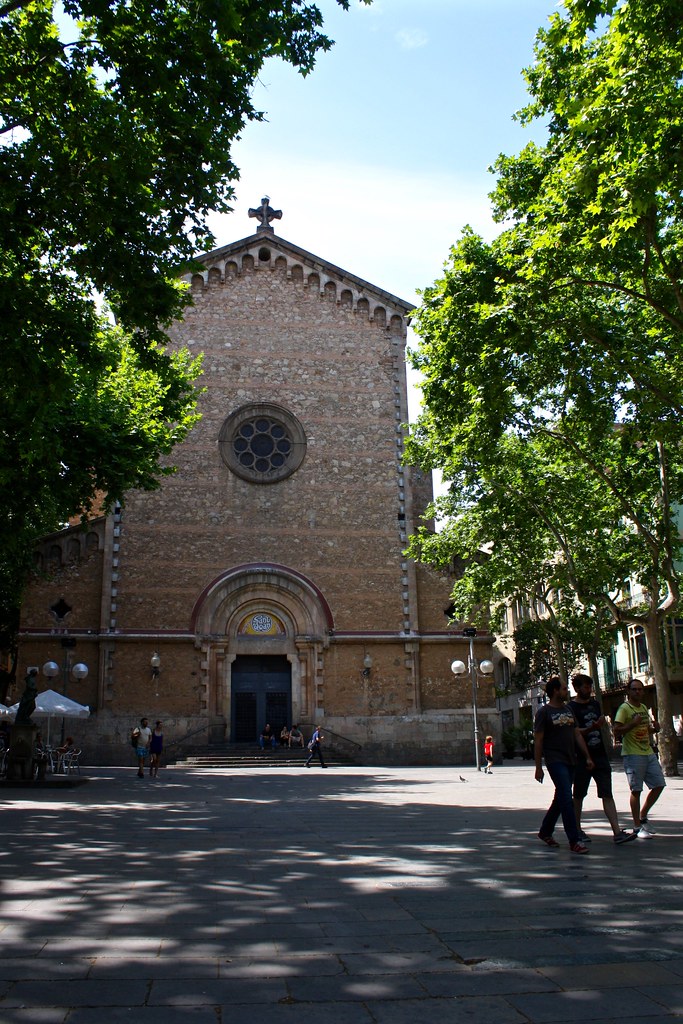 |
| Plaça de la Virreina, Gràcia |
It wasn’t until June of 2015 that I realized Barcelona wasn’t so bad after all, but not for the reasons that most folks visit the city in droves. The neighborhood of Gràcia, far to the north of the touristy core, totally changed how I felt about Barcelona.
Over the years, this charming district slowly made its way onto my radar screen. Jessica of Barcelona Blonde first tipped me off to Gràcia after she moved into an apartment there; I was so amazed that such a cool place was hiding in plain sight in the middle of a world-class city! And then the folks at Devour Spain expanded their food tours in Madrid to Catalunya, inaugurating their Barcelona branch with a food tour of this neighborhood. It was clear I had to return to see what all the hype was about!
 |
| Tree-lined city streets in Gràcia |
So when I did get back to Barcelona two summers ago, I decided to forgo a centrally-located hostel in the Barri Gòtic and instead go for one nestled up against the foothills of Park Güell. From my perch on the northern edge of Gràcia I hopped from one bustling plaza to another, grabbing snacks at locals-only vermouth bars along the way.
Now, what makes Gràcia, well, Gràcia?
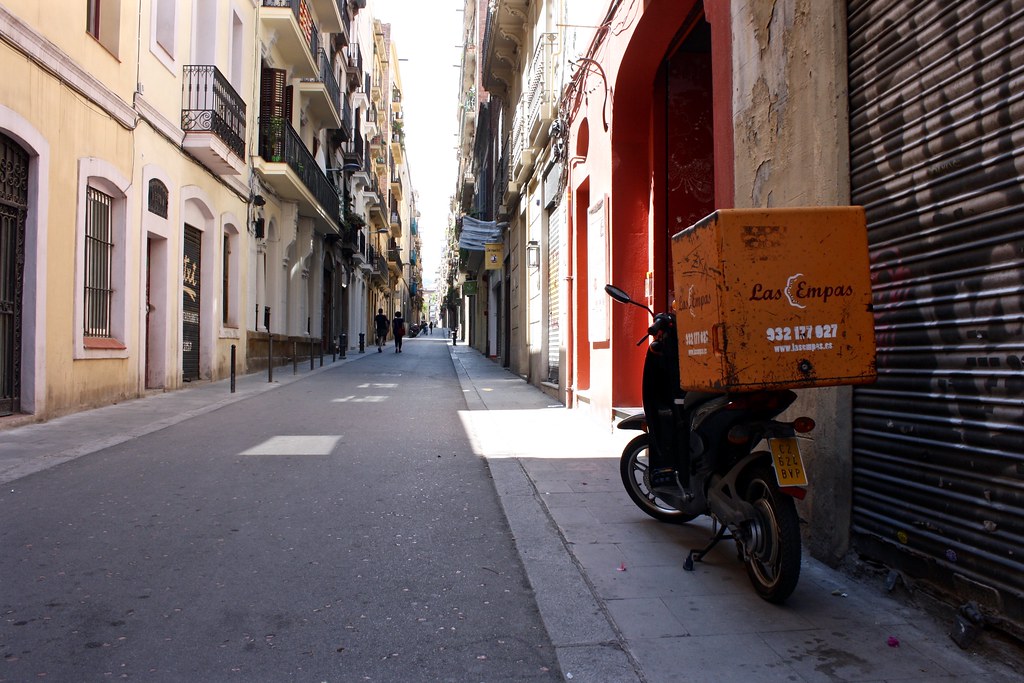 |
| Narrow, shaded streets in Gràcia |
I think the biggest thing that sets this neighborhood apart from the rest of the Big City is its small-town feel. Gràcia was actually once a separate village north of Barcelona’s historic center, but as the city sprawled around the turn of the century, the Vila de Gràcia was essentially absorbed into the city. Even today, the area still retains narrow, sometimes-wandering streets with small block sizes and apartment homes that rarely reach more than three stories tall. These cozy city streets are broken up by a handful of lively plazas where folks sip coffee or beer on sunny patios and kids kick soccer balls off of parish church walls.
 |
| Colorful seltzer bottles, Inch Bar |
Compared to the endless traffic of the Eixample district to the south, few cars clog up the roads here, making the neighborhood a quiet escape from the city whose only soundtrack is the conversations of locals who ran into each other on the street, garlic sizzling in frying pans through kitchen windows, and milk wailing as it steams in tiny coffee shops.
Of course, Gràcia can get pretty loud in its own right—especially in the summer during the weeklong Festa Major de Gràcia. As my friend Jessica recounts, the whole neighborhood gets festooned in whimsical decorations and denizens celebrate all night long, but having fireworks go off at ungodly hours can make sleep, uh, difficult. But hey, what’s a Spanish small town without its annual party?
 |
| Ca’l Pep |
In many ways Gràcia is also what much of Barcelona used to be like before the core was overwhelmed by tourists and cruise ship daytrippers. Here, there’s nary a Starbucks to be found; instead, closet-sized “supermarkets” offer the essential groceries for the day while family-owned coffee shops, bars, and restaurants are the norm, not the exception. In Gràcia’s major market, the Mercat de l’Abaceria Central, you’ll run into more two-wheeled shopping totes than camera-toting visitors. And you might feel like you’re intruding when you step in to a tavern with sun-bleached posters, dusty wine bottles in the rafters, and regulars who have been regulars for probably decades—but that’s the mark of an authentic spot, to be sure.
 |
| Pretty houses in Gràcia |
To top it all off, you’ll likely see no other fellow tourists in Gràcia, so you’ll feel like you have the whole neighborhood to yourself while you’re there.
There’s no finer pleasure in Gràcia than tasting everything the neighborhood has to offer, from the traditional Catalan apéritif of vermouth to Catalan staples like pa amb tomàquet, toast rubbed with tomatoes. Where to eat, then?
 |
| A bomba tapa from L’Anxoveta |
L’Anxoveta (C/ Sant Domènec, 16) is a great place to start; after all, its name is Catalan for “the anchovy”! I dipped in here on a sleepy Sunday but was quickly awoken after trying their signature bomba tapa—a hefty potato croquette paired with savory aioli and spicy tomato sauce meant to recall the bombs thrown by anarchists during the Spanish Civil War.
I had a quality breakfast at Can Tosca (C/Torrent de l’Olla, 77) during my brief stay in this neighborhood. Their café con leche was a little runny, but they made up for it with a sandwich of tender botifarra sausage placed between two toasted slices of thin, bubbly pa de vidre bread rubbed with juicy tomatoes.
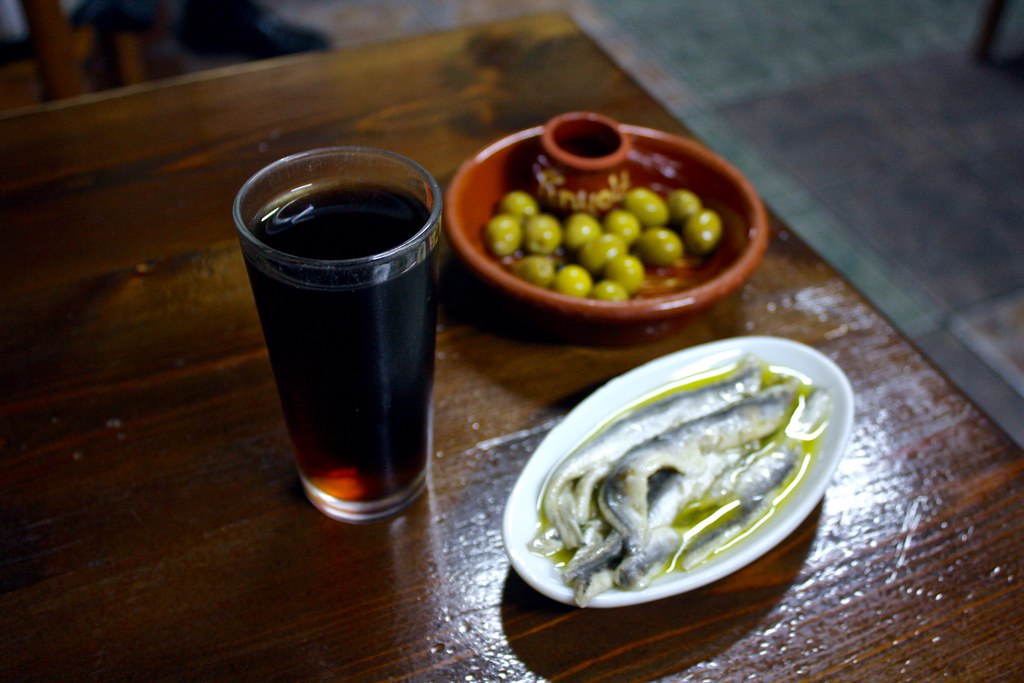 |
| Vermouth + anchovies at Ca’l Pep |
Ca’l Pep (C/ Verdi, 141) was the most authentic place I visited in Barcelona. The average age here was around 60, leafed-through newspapers lay on every table, and large barrels of homemade vermouth sat out in the open—I even saw one guy come in with an empty jug and fill up his own stash to take home. If you get nothing else here, get their boquerones en vinagre; these cured anchovies are seriously the best I’ve ever tasted in Spain, super tender and not fishy at all.
I stumbled across Inch Bar (C/ Escorial, 117) on my daily hikes down and back up to the hostel. Although it looked barely an inch wide from the street, it opened up inside and served me a refreshing local Moritz beer and open-face sausage sandwich.
 |
| White and red varieties of sweet vermouth at La Vermú |
La Vermut (C/ Sant Domènec, 15), as the name would suggest, is a great place to try this typical Catalan apéritif. Decorated in a spare black, white, and red color scheme, it focuses your attention on the food and drinks. I recommend pairing a red vermouth with paper-thin slices of fuet sausage.
It was bars and restaurants like these that helped me finally gain a healthy appreciation for Barcelona—even if they made me want to never leave the neighborhood of Gràcia at all.
Have you ever spent time in Gràcia before? Would this neighborhood make you rethink your impressions of Barcelona? Share your thoughts below in the discussion thread!
